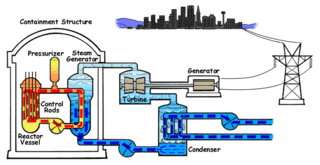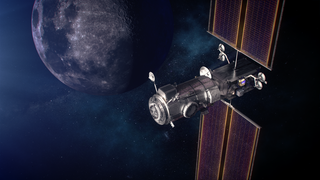
An ion thruster, ion drive, or ion engine is a form of electric propulsion used for spacecraft propulsion. It creates thrust by accelerating ions using electricity.

A magnetoplasmadynamic (MPD) thruster (MPDT) is a form of electrically powered spacecraft propulsion which uses the Lorentz force to generate thrust. It is sometimes referred to as Lorentz Force Accelerator (LFA) or MPD arcjet.

A nuclear thermal rocket (NTR) is a type of thermal rocket where the heat from a nuclear reaction, often nuclear fission, replaces the chemical energy of the propellants in a chemical rocket. In an NTR, a working fluid, usually liquid hydrogen, is heated to a high temperature in a nuclear reactor and then expands through a rocket nozzle to create thrust. The external nuclear heat source theoretically allows a higher effective exhaust velocity and is expected to double or triple payload capacity compared to chemical propellants that store energy internally.

Nuclear propulsion includes a wide variety of propulsion methods that use some form of nuclear reaction as their primary power source. The idea of using nuclear material for propulsion dates back to the beginning of the 20th century. In 1903 it was hypothesized that radioactive material, radium, might be a suitable fuel for engines to propel cars, planes, and boats. H. G. Wells picked up this idea in his 1914 fiction work The World Set Free.

The Nuclear Engine for Rocket Vehicle Application (NERVA) was a nuclear thermal rocket engine development program that ran for roughly two decades. Its principal objective was to "establish a technology base for nuclear rocket engine systems to be utilized in the design and development of propulsion systems for space mission application". NERVA was a joint effort of the Atomic Energy Commission (AEC) and the National Aeronautics and Space Administration (NASA), and was managed by the Space Nuclear Propulsion Office (SNPO) until the program ended in January 1973. SNPO was led by NASA's Harold Finger and AEC's Milton Klein.

The Angara rocket family is a family of launch vehicles being developed by the Moscow-based Khrunichev State Research and Production Space Center. The launch vehicles are to put between 3,800 kg (8,400 lb) and 24,500 kg (54,000 lb) into low Earth orbit and are intended, along with Soyuz-2 variants, to replace several existing launch vehicles.

Naro-1, previously designated the Korea Space Launch Vehicle or KSLV, is South Korea's first carrier rocket, and the first South Korean launch vehicle to achieve Earth orbit. On January 30, 2013, the third Naro-1 vehicle built successfully placed STSAT-2C into low Earth orbit.

The Vostochny Cosmodrome is a Russian spaceport above the 51st parallel north in the Amur Oblast, in the Russian Far East. It is intended to reduce Russia's dependency on the Baikonur Cosmodrome in Kazakhstan. The first launch took place on 28 April 2016 at 02:01 UTC. As of 1 July 2021, eight launch attempts have been made with seven successes.
Mars Piloted Orbital Station is a Russian concept for an orbital human mission to Mars, with several proposed configurations, including using a nuclear reactor to run an electric rocket engine. A 30-volume draft proposal was produced in 2005. The design for the proposed ship was proposed to be ready in 2012, and the ship itself in 2021. The concept did not undergo detailed design nor development.

The Astravets Nuclear Power Plant is a nuclear power plant located in the Astravyets District, Grodno Regionin north-western Belarus. The power plant is built close to the Belarus-Lithuania border, being 40 kilometres (25 mi) east of the Lithuanian capital of Vilnius. The plant is powered by a 1194-MW VVER-1200 unit supplied by Atomstroyexport, the nuclear equipment exporter branch of the Russian nuclear corporation Rosatom. Another 1194-MW VVER-1200 unit is under construction. The plant is owned by State Enterprise Belarusian NPP, which in turn is owned by the state-owned operator Belenergo.

Orel or Oryol, formerly Federation, and PPTS, is a project by Roscosmos to develop a new-generation, partially reusable crewed spacecraft.

Project Rover was a United States project to develop a nuclear-thermal rocket that ran from 1955 to 1973 at the Los Alamos Scientific Laboratory (LASL). It began as a United States Air Force project to develop a nuclear-powered upper stage for an intercontinental ballistic missile (ICBM). The project was transferred to NASA in 1958 after the Sputnik crisis triggered the Space Race. It was managed by the Space Nuclear Propulsion Office (SNPO), a joint agency of the Atomic Energy Commission (AEC), and NASA. Project Rover became part of NASA's Nuclear Engine for Rocket Vehicle Application (NERVA) project and henceforth dealt with the research into nuclear rocket reactor design, while NERVA involved the overall development and deployment of nuclear rocket engines, and the planning for space missions.

The China Experimental Fast Reactor (CEFR) is China's first fast nuclear reactor, and is located outside Beijing at the China Institute of Atomic Energy. It aims to provide China with fast-reactor design, construction, and operational experience, and will be a key facility for testing and researching components and materials to be used in subsequent fast reactors. The reactor achieved first criticality on July 21, 2010 and started generating power a year later on July 21, 2011. On October 2012 Xinhua announced that the CEFR has passed official checks. The CEFR was brought to full power at 5.00pm on 15 December 2014 and operated at this level continuously for three full days.

This following table is a comparison of orbital launcher families. To see lists of all launch systems, separated by current operational status, see Comparison of orbital launch systems.

Nuclear power in space is the use of nuclear power in outer space, typically either small fission systems or radioactive decay for electricity or heat. Another use is for scientific observation, as in a Mössbauer spectrometer. The most common type is a radioisotope thermoelectric generator, which has been used on many space probes and on crewed lunar missions. Small fission reactors for Earth observation satellites, such as the TOPAZ nuclear reactor, have also been flown. A radioisotope heater unit is powered by radioactive decay and can keep components from becoming too cold to function, potentially over a span of decades.

A super heavy-lift launch vehicle (SHLLV) is a launch vehicle capable of lifting more than 50 tonnes (110,000 lb) or 100 tonnes (220,000 lb) of payload into low Earth orbit (LEO), more than a heavy-lift launch vehicle.

Irtysh, also named Soyuz-5, formerly codenamed Fenix in Russian and Sunkar in Kazakh, is a planned Russian rocket that is being developed by JSC SRC Progress within the "Project Feniks". Initially it will replace the capability of Zenit-2 and Proton Medium, and in the future will serve as the base of a super heavy-lift launch vehicle rocket (Yenisei) to match the Energia/Buran capabilities. As of February 2021, Irtysh is expected to launch from the Baikonur Baiterek, the ex Zenit-2 launch site, in a partnership with the government of Kazakhstan, with a planned debut in late 2023.

This article documents expected notable spaceflight events during the year 2024.

This article documents expected notable spaceflight events during the year 2025.
Yenisei, project name RN STK-1, was the first super-heavy launch vehicle being developed by the Russian space industry since the fall of the USSR. The main developer is RSC Energia.


















